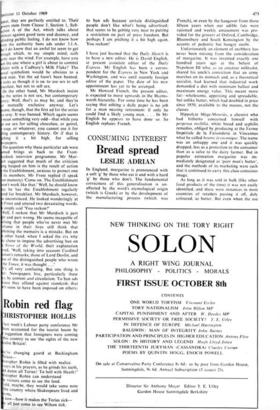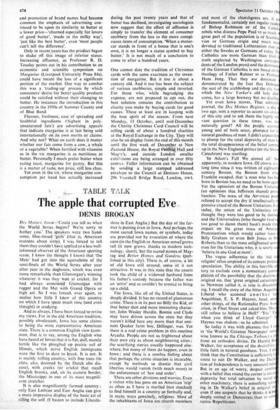CONSUMING INTEREST
Bread spread
LESLIE ADRIAN
In England, margarine is pronounced with a soft `g' by those who eat it and with a hard 'g' by those who don't. The fundamental correctness of this generalisation is un- affected by the word's etymological origin (which is Greek) or by the development of the manufacturing process (which was French), or even by the hangover from those fifteen years when our edible fats were rationed and weekly amusement was pro- vided for the grocers of Oxford, Cambridge, Bloomsbury and South Kensington by the accents of pedantic but hungry snobs.
Unfortunately an element of snobbery has never been missing from the consideration of margarine. It was invented exactly one hundred years ago at the behest of Napoleon III who, as an amateur militarist, shared his uncle's conviction that an army marches on its stomach and, as a theoretical socialist, had learned that industrial work demanded a diet with minimum ballast and maximum energy value. This meant more fat—wholesome, appetising and spreadable, but unlike butter, which had doubled in price since 1850, available to the masses, not the classes.
Hippolyte Mege-Mouries, a chemist who had hitherto concerned himself with perpetua mobilia, white bread and syphilis remedies, obliged by producing at the Ferme Impdriale de la Faisanderie in Vincennes what he called beurre economique. The name was an unhappy one and it was quickly dropped, less as a protection to the consumer than as a salve to the dairy farmer. But in popular estimation margarine was im- mediately designated as 'poor man's butter', and the methods of its marketing were such that it continued.to carry this class-conscious image.
As long as it was sold in bulk (like other food products of the time) it was not easily identified, and there were instances in most countries of retailers passing it off, duly coloured, as butter. But even when the use and promotion of brand names had become common the emphasis of advertising con- tinued to be upon its similarity to butter at a lower price—`churned especially for lovers of good butter', 'made in the milky way', 'just like the best butter', even 'most people can't tell the difference'.
Only in recent years has the product begun to shake off this image of inferior status. Increasing affluence, as Professor R. D. Tousley points out in his contribution to an economic and scientific symposium on Margarine (Liverpool University Press 84s), could have meant the loss of a significant portion of the market. One way to combat this was a `trading-up' process by which consumers' desire for better quality products could be satisfied without their changing to butter. He instances the introduction in this country in the 1950s of Summer County and of Blue Band.
Flavour, freshness, ease of spreading and healthful ingredients ('highest in poly- unsaturated fats') are advertising appeals that indicate margarine is at last being sold internationally on its own merits or claims. And why not? What on earth does it matter whether our fats come from a cow, a whale or a vegetable? When fortified with vitamins as in the ix margarine is as nutritious as butter. Personally I much prefer butter when eating toast, margarine for pastry. But this is a matter of taste, not price, still less class.
Yet even in the us, where margarine con- sumption per head has actually increased during the past twenty years and that of butter has declined, investigating sociologists now suggest that the effect of affluence is simply to transfer the element of consumer snobbery from the less to the more conspi- cuous items of consumption. 'When a motor- car stands in front of a house that is one's own, it is no longer a status symbol to buy butter.' It is not much of a conclusion to come to after a hundred years.
One cannot date the tradition of Christmas cards with the same exactness as the inven- tion of margarine. But it too is about a century old. And it too has been the subject of various snobberies, simple and inverted. For those who, while begrudging the expense, are not prepared to opt out, the best solution remains the contribution to charity you make by buying cards for good causes. These at least are in keeping with the true spirit of the season. From next Monday, 13 October, until mid-December the Charity Christmas Card Council will be selling cards of about a hundred charities at the Royal Exchange in the City. "I;hey will also be on display from the end of this month until the first week of Deceiqer at New Zealand House, the Royal Fát4 Hall and Map'e's, and outside London smaller exhibitions are being arranged in over fifty centres. Fuller information can be obtained by sending a large stamped addressed envelope to the Council at Denison House, 296 Vauxhall Bridge Road, London, swl.











































 Previous page
Previous page